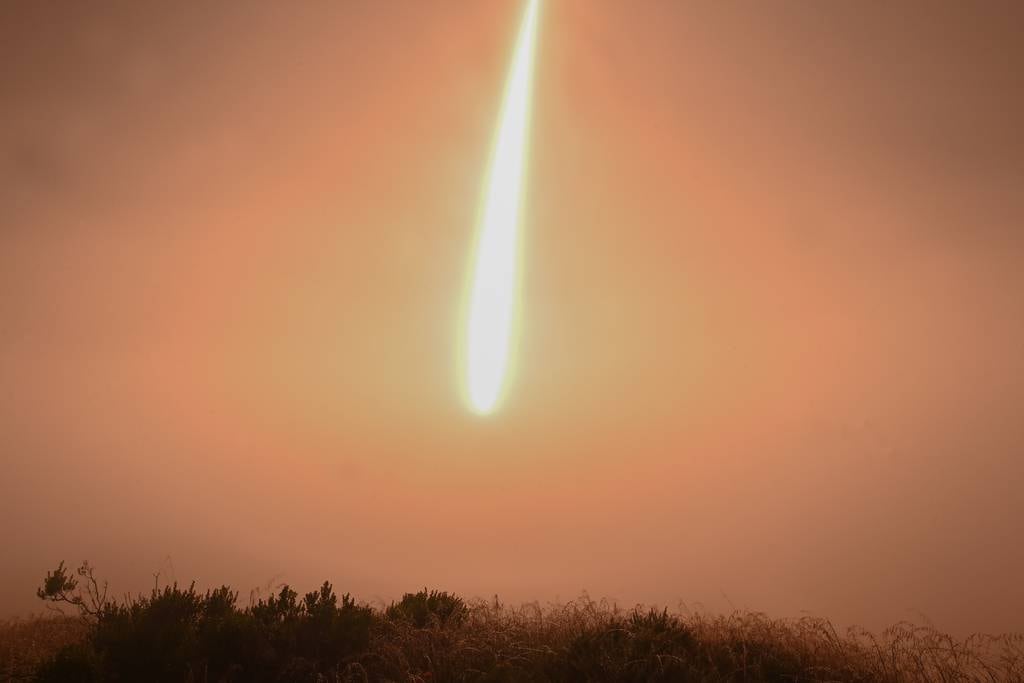
The U.S. military test-fired two unarmed Minuteman III intercontinental ballistic missiles this week, with the Air Force noting they were not driven by “current world events.”
The tests, which involved the Air Force and Space Force, took place June 4 and June 6 from Vandenberg Space Force Base, California, Air Force Global Strike Command noted in its news releases. That command is tasked with handling two legs of the United States’ nuclear triad, which is made up of land-, submarine- and bomber-launched nuclear weapons.
A spokesperson for the command told Defense News both tests were “successful.”
“The U.S. nuclear enterprise is the cornerstone of security for our allies and partners across the globe,” Col. Chris Cruise, the head of the 377th Test and Evaluation Group, said in the June 4 announcement. “Today’s test launch is just one example of how our nation’s ICBMs, and the professional Airmen who maintain and operate them, demonstrate the readiness and reliability of the weapon system. It showcases our commitment to deterrence as we stand on continuous alert, 24/7/365.”
The reentry vehicle of each missile traveled approximately 4,200 miles to the Ronald Reagan Ballistic Missile Defense Test Site on the Kwajalein Atoll, Republic of the Marshall Islands. Reentry vehicles are the top part of the ICBM that carry the nuclear warhead. They are designed to detach from the missile, arc in space and then reenter Earth’s atmosphere to hit their intended target.
The Minuteman III ICBM system first became operational in the 1970s and was expected to be in service for a decade. But now, about 50 years later, the weapons are still in use and will be until the 2030s, according to a November statement by Rep. Mike Rogers, R-Ala., who chairs the House Armed Service Committee.
The military had intentionally destroyed an unarmed ICBM earlier in the month during a test due to an anomaly, the Air Force said at the time.
“We must modernize our aging nuclear deterrent and replace the Minuteman III missile — as well as the rest of our nuclear enterprise — with modern systems,” Rogers said in response to the aborted test.
Indeed, the Air Force intends to field its next ICBM, dubbed Sentinel, though the program is behind schedule and its cost has grown beyond what was anticipated. After a delay, the missile’s first test flight is expected to take place in February 2026, according to the Air Force’s budget documents.
In a joint March news release, Sen. Elizabeth Warren of Massachusetts and Rep. John Garamendi of California noted inconsistencies in the Air Force’s timeline for replacing the Minuteman III.
“The Sentinel program would replace the Minuteman III program ICBM, which had been deemed viable until the mid-2030s by Air Force leaders with no potential extension of its service life. However, this timeline is inconsistent with the Air Force’s plans to continue to maintain the Minuteman III program for the next 15 to 20 years while the Sentinel program is rolled out in stages,” the two Democrats said. “Even assuming the Air Force is able to meet its intended timeline, the Air Force must rely on the Minuteman III until at least 2036.”
This story was updated June 7, 2024, at 1:08 p.m. ET with a statement from Air Force Global Strike Command.
Cristina Stassis is an editorial fellow for Defense News and Military Times, where she covers stories surrounding the defense industry, national security, military/veteran affairs and more. She is currently studying journalism and mass communication and international affairs at the George Washington University.
- SEO Powered Content & PR Distribution. Get Amplified Today.
- PlatoData.Network Vertical Generative Ai. Empower Yourself. Access Here.
- PlatoAiStream. Web3 Intelligence. Knowledge Amplified. Access Here.
- PlatoESG. Carbon, CleanTech, Energy, Environment, Solar, Waste Management. Access Here.
- PlatoHealth. Biotech and Clinical Trials Intelligence. Access Here.
- Source: https://www.defensenews.com/training-sim/2024/06/06/us-test-fires-two-unarmed-minuteman-iii-ballistic-missiles/



